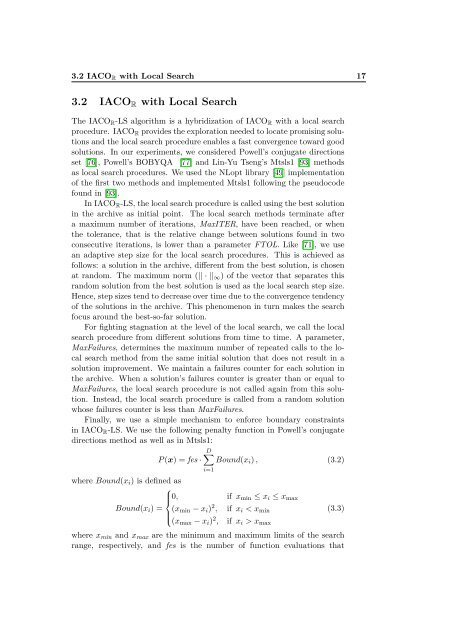Improved ant colony optimization algorithms for continuous ... - CoDE
Improved ant colony optimization algorithms for continuous ... - CoDE
Improved ant colony optimization algorithms for continuous ... - CoDE
Create successful ePaper yourself
Turn your PDF publications into a flip-book with our unique Google optimized e-Paper software.
3.2 IACOR with Local Search 17<br />
3.2 IACOR with Local Search<br />
The IACOR-LS algorithm is a hybridization of IACOR with a local search<br />
procedure. IACOR provides the exploration needed to locate promising solutions<br />
and the local search procedure enables a fast convergence toward good<br />
solutions. In our experiments, we considered Powell’s conjugate directions<br />
set [76], Powell’s BOBYQA [77] and Lin-Yu Tseng’s Mtsls1 [93] methods<br />
as local search procedures. We used the NLopt library [49] implementation<br />
of the first two methods and implemented Mtsls1 following the pseudocode<br />
found in [93].<br />
In IACOR-LS, the local search procedure is called using the best solution<br />
in the archive as initial point. The local search methods terminate after<br />
a maximum number of iterations, MaxITER, have been reached, or when<br />
the tolerance, that is the relative change between solutions found in two<br />
consecutive iterations, is lower than a parameter FTOL. Like [71], we use<br />
an adaptive step size <strong>for</strong> the local search procedures. This is achieved as<br />
follows: a solution in the archive, different from the best solution, is chosen<br />
at random. The maximum norm (|| · ||∞) of the vector that separates this<br />
random solution from the best solution is used as the local search step size.<br />
Hence, step sizes tend to decrease over time due to the convergence tendency<br />
of the solutions in the archive. This phenomenon in turn makes the search<br />
focus around the best-so-far solution.<br />
For fighting stagnation at the level of the local search, we call the local<br />
search procedure from different solutions from time to time. A parameter,<br />
MaxFailures, determines the maximum number of repeated calls to the local<br />
search method from the same initial solution that does not result in a<br />
solution improvement. We maintain a failures counter <strong>for</strong> each solution in<br />
the archive. When a solution’s failures counter is greater than or equal to<br />
MaxFailures, the local search procedure is not called again from this solution.<br />
Instead, the local search procedure is called from a random solution<br />
whose failures counter is less than MaxFailures.<br />
Finally, we use a simple mechanism to en<strong>for</strong>ce boundary constraints<br />
in IACOR-LS. We use the following penalty function in Powell’s conjugate<br />
directions method as well as in Mtsls1:<br />
D<br />
P (x) = fes · Bound(xi) , (3.2)<br />
i=1<br />
where Bound(xi) is defined as<br />
⎧<br />
⎪⎨<br />
Bound(xi) = (xmin − xi)<br />
⎪⎩<br />
2 , if xi < xmin<br />
(xmax − xi) 2 , if xi > xmax<br />
0, if xmin ≤ xi ≤ xmax<br />
(3.3)<br />
where xmin and xmax are the minimum and maximum limits of the search<br />
range, respectively, and fes is the number of function evaluations that

















